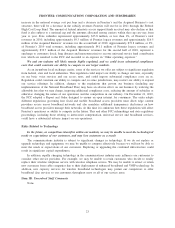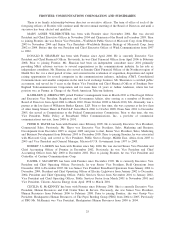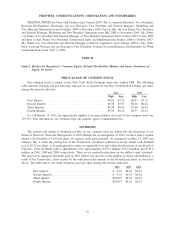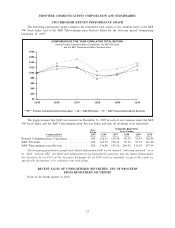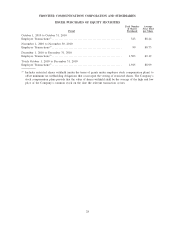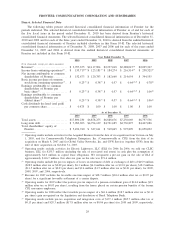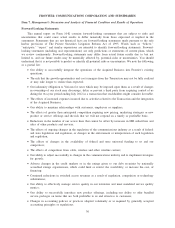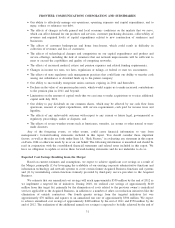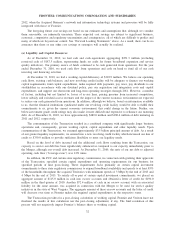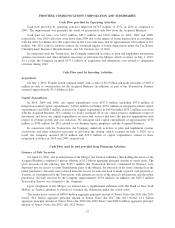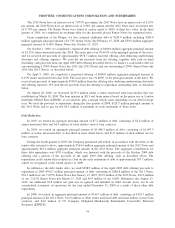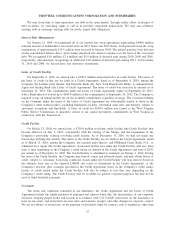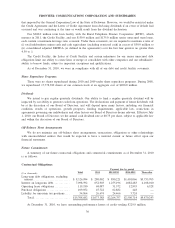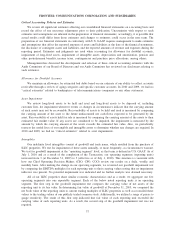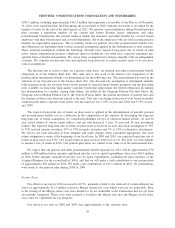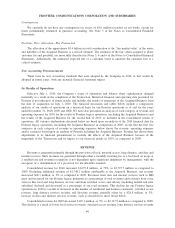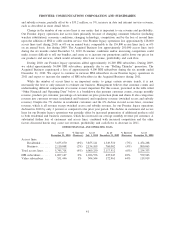Frontier Communications 2010 Annual Report Download - page 33
Download and view the complete annual report
Please find page 33 of the 2010 Frontier Communications annual report below. You can navigate through the pages in the report by either clicking on the pages listed below, or by using the keyword search tool below to find specific information within the annual report.2012, when the Acquired Business’s network and information technology systems and processes will be fully
integrated with those of Frontier.
The foregoing future cost savings are based on our estimates and assumptions that, although we consider
them reasonable, are inherently uncertain. These expected cost savings are subject to significant business,
economic, competitive and regulatory uncertainties and contingencies, all of which are difficult to predict and
many of which are beyond our control. See “Forward Looking Statements” above. As a result, there can be no
assurance that these or any other cost savings or synergies will actually be realized.
(a) Liquidity and Capital Resources
As of December 31, 2010, we had cash and cash equivalents aggregating $251.3 million (excluding
restricted cash of $187.5 million, representing funds set aside for future broadband expansion and service
quality initiatives). Our primary source of funds continued to be cash generated from operations. For the year
ended December 31, 2010, we used cash flow from operations and cash on hand to fund all of our cash
investing and financing activities.
At December 31, 2010, we had a working capital deficiency of $310.9 million. We believe our operating
cash flows, existing cash balances, and new revolving credit facility will be adequate to finance our working
capital requirements, fund capital expenditures, make required debt payments, pay taxes, pay dividends to our
stockholders in accordance with our dividend policy, pay our acquisition and integration costs and capital
expenditures, and support our short-term and long-term operating strategies through 2011. However, a number
of factors, including but not limited to, losses of access lines, pricing pressure from increased competition,
lower subsidy and switched access revenues and the impact of the current economic environment are expected
to reduce our cash generated from operations. In addition, although we believe, based on information available
to us, that the financial institutions syndicated under our revolving credit facility would be able to fulfill their
commitments to us, given the current economic environment, this could change in the future. Further, our
below-investment grade credit ratings may also make it more difficult and expensive to refinance our maturing
debt. As of December 31, 2010, we have approximately $280.0 million and $180.4 million of debt maturing in
2011 and 2012, respectively.
The consummation of the Transaction resulted in a combined company with significantly larger business
operations and, consequently, greater working capital, capital expenditure and other liquidity needs. Upon
consummation of the Transaction, we assumed approximately $3.5 billion principal amount of debt. As a result
of our greater liquidity requirements, we entered into a new revolving credit facility which increased our line of
credit to $750.0 million to provide sufficient flexibility to meet our liquidity needs.
Based on the level of debt incurred and the additional cash flows resulting from the Transaction, our
capacity to service our debt has been significantly enhanced as compared to our capacity immediately prior to
the Merger, although our overall debt increased. At December 31, 2010, the ratio of our net debt to adjusted
operating cash flow (“leverage ratio”) was 2.98 times.
In addition, the FCC and certain state regulatory commissions, in connection with granting their approvals
of the Transaction, specified certain capital expenditure and operating requirements for our business for
specified periods of time post-closing. These requirements focus primarily on certain capital investment
commitments to three state regulatory commissions to expand broadband availability and speeds to at least 85%
of the households throughout the acquired Territories with minimum speeds of 3 Mbps by the end of 2013 and
4 Mbps by the end of 2015. To satisfy all or part of certain capital investment commitments, we placed an
aggregate amount of $115.0 million in cash into escrow accounts and obtained a letter of credit for $190.0
million in the third quarter of 2010. Another $72.4 million of cash in an escrow account, with an associated
liability for the same amount, was acquired in connection with the Merger to be used for service quality
initiatives in the state of West Virginia. The aggregate amount of these escrow accounts and the letter of credit
will decrease over time as Frontier makes the required capital expenditures in the respective states.
The Transaction provides for a post-closing calculation of working capital. Frontier and Verizon have not
finalized the results of this calculation nor the post-closing adjustment, if any. The final resolution of this
process will not negatively impact Frontier’s balance sheet or working capital.
32
FRONTIER COMMUNICATIONS CORPORATION AND SUBSIDIARIES



